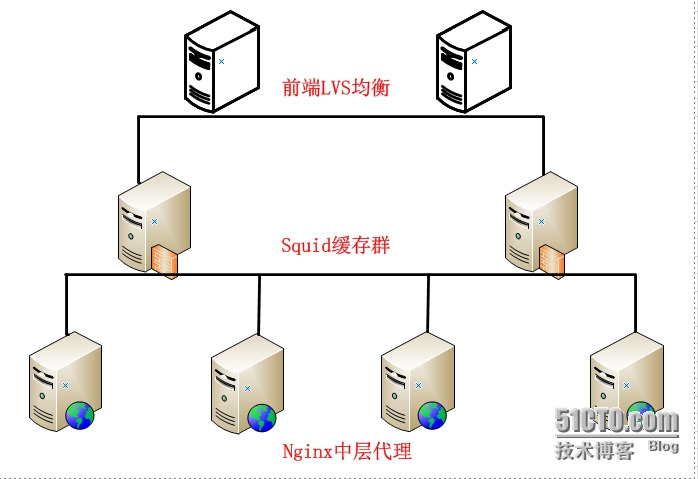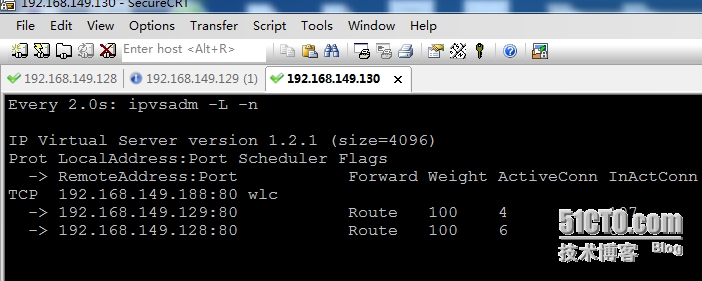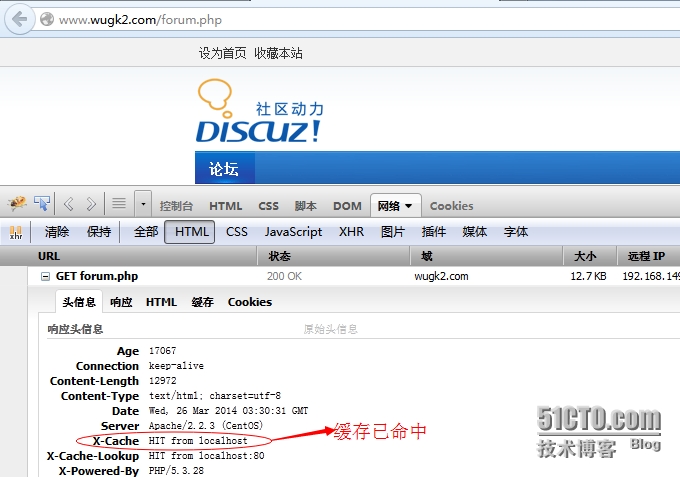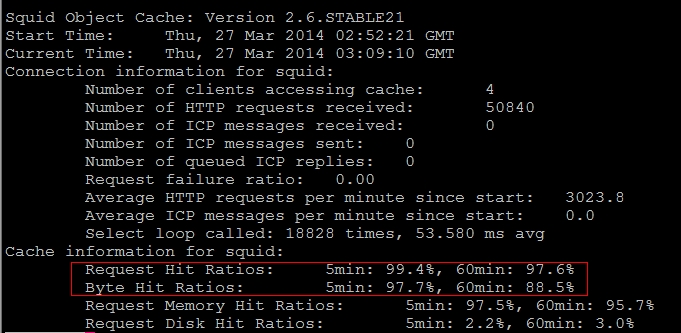前言* 随着网站访问人数越来越多,承受的并发和压力也越来越高,这时候我们需要对网站和架构进行优化,今天我们来讨论使用Squid对架构进行优化,缓存网站。网上对squid描述的文章也有成千上万,我这里简单记录一下实践的步骤。
一、实施环境
|
1
2
3
|
系统版本:CentOSx86_64 5.8
Squid版本:squid-2.6
Nginx版本:nginx-1.4.2
|
二、正式安装
安装之前我们需要对系统进行优化,主要优化系统内核相关参数,仅供参考:
|
1
2
3
4
5
6
7
8
9
10
11
12
13
14
15
16
17
18
19
20
21
22
23
24
25
26
27
28
29
30
31
32
33
34
|
vi
/etc/sysctl
.conf
#sysctl.conf config 2014-03-26
net.ipv4.ip_forward = 0
net.ipv4.conf.default.rp_filter = 1
net.ipv4.conf.default.accept_source_route = 0
kernel.sysrq = 0
kernel.core_uses_pid = 1
net.ipv4.tcp_syncookies = 1
kernel.msgmnb = 65536
kernel.msgmax = 65536
kernel.shmmax = 68719476736
kernel.shmall = 4294967296
net.ipv4.tcp_max_tw_buckets = 10000
net.ipv4.tcp_sack = 1
net.ipv4.tcp_window_scaling = 1
net.ipv4.tcp_rmem = 4096 87380 4194304
net.ipv4.tcp_wmem = 4096 16384 4194304
net.core.wmem_default = 8388608
net.core.rmem_default = 8388608
net.core.rmem_max = 16777216
net.core.wmem_max = 16777216
net.core.netdev_max_backlog = 262144
net.core.somaxconn = 262144
net.ipv4.tcp_max_orphans = 3276800
net.ipv4.tcp_max_syn_backlog = 262144
net.ipv4.tcp_timestamps = 0
net.ipv4.tcp_synack_retries = 1
net.ipv4.tcp_syn_retries = 1
net.ipv4.tcp_tw_recycle = 1
net.ipv4.tcp_tw_reuse = 1
net.ipv4.tcp_mem = 94500000 915000000 927000000
net.ipv4.tcp_fin_timeout = 1
net.ipv4.tcp_keepalive_time = 15
net.ipv4.ip_local_port_range = 1024 65535
|
优化Linux文件打开最大数:
|
1
2
3
4
5
|
vi
/etc/security/limits
.conf
* soft nproc 65535
* hard nproc 65535
* soft nofile 65535
* hard nofile 65535
|
接下来上自动安装Squid脚本,里面分别配置了两个虚拟主机域名,前端有LVS,LVS均衡后端多组squid集群,根据命中率去调整squid集群的数量,Squid后端均衡Nginx或者Apache。(完整的架构LVS+Keepalived+Squid+Nginx+Resin/Tomcat/PHP+MySQL集群)
简单逻辑图如下:
直接上脚本:
|
1
2
3
4
5
6
7
8
9
10
11
12
13
14
15
16
17
18
19
20
21
22
23
24
25
26
27
28
29
30
31
32
33
34
35
36
37
38
39
40
41
42
43
44
45
46
47
48
49
50
51
52
53
54
55
56
57
58
59
60
61
62
63
64
65
66
67
68
69
70
|
#!/bin/sh
#Auto make install squid server
#Author wugk 2014-03-26
SQUID_CNF=
/etc/squid/squid
.conf
CACHE_DIR=(
/data/cache1
/data/cache2
)
#Install squid shell
yum
install
-y squid
#config squid.conf
cat
>>$SQUID_CNF <<EOF
#global config squid.conf 2014-03-26
http_port 80 accel vhost vport
cache_peer 192.168.149.128 parent 80 0 originserver name=wugk1
cache_peer 192.168.149.129 parent 80 0 originserver name=wugk2
cache_peer_domain wugk1 www.wugk1.com
cache_peer_domain wugk2 www.wugk2.com
visible_hostname localhost
forwarded_for off
via off
cache_vary on
#acl config
acl manager proto cache_object
acl localhost src 127.0.0.1
/32
acl to_localhost dst 127.0.0.0
/8
0.0.0.0
/32
acl localnet src 10.0.0.0
/8
# RFC1918 possible internal network
acl localnet src 172.16.0.0
/12
# RFC1918 possible internal network
acl localnet src 192.168.0.0
/16
# RFC1918 possible internal network
acl SSL_ports port 443
acl Safe_ports port 80 8080
# http
acl Safe_ports port 21
# ftp
acl Safe_ports port 443
# https
acl all src 0.0.0.0
/0
acl CONNECT method CONNECT
http_access allow manager localhost
http_access deny manager
http_access deny !Safe_ports
http_access deny CONNECT !SSL_ports
http_access allow localnet
http_access allow localhost
http_access allow all
acl PURGE method PURGE
http_access allow PURGE localhost
http_access deny PURGE
#squid config 2014-03-25
cache_dir aufs
/data/cache1
10240 16 256
cache_dir aufs
/data/cache2
10240 16 256
cache_mem 4000 MB
maximum_object_size 8 MB
maximum_object_size_in_memory 256 KB
hierarchy_stoplist cgi-bin ?
coredump_dir
/var/spool/squid
refresh_pattern ^
ftp
: 1440 20% 10080
refresh_pattern ^gopher: 1440 0% 1440
refresh_pattern -i (
/cgi-bin/
|\?) 0 0% 0
refresh_pattern \.(jpg|png|gif|mp3|xml|html|htm|css|js) 1440 50% 2880 ignore-reload
refresh_pattern . 0 20% 4320
EOF
#config cache_dir
mkdir
-p ${CACHE_DIR[@]} ;
chown
-R squid:squid ${CACHE_DIR[@]}
#restart squid server
/etc/init
.d
/squid
restart
if
[
"$?"
==
"0"
];
then
echo
"The Squid Server Install Successfully !!"
else
echo
"The Squid Server Install Failed !!,Please Check Log......"
fi
|
最后测试,前端LVS截图(注LVS此处不配置了,博客有专门的安装方法)
通过浏览器查看head头,缓存命中情况截图如下:
通过命令
|
1
|
squidclient -p
80
mgr:info |egrep
"(Request Hit Ratios|Byte Hit Ratios)"
|
查看缓存命中率如下:
三、批量清空缓存
使用Shell脚本批量清空squid缓存脚本auto_clean_cache.sh
|
1
2
3
4
5
6
7
8
9
10
11
12
13
14
15
16
17
18
19
20
21
22
|
#!/bin/sh
DIR=
/data/cache/
Command=
/usr/sbin/squidclient
if
[
"$1"
=
""
];
then
echo
"Usage:{$0 "
\$1
" ,Example exec $0 forum.php}"
exit
fi
grep
-r -a $1 ${DIR} | strings |
grep
"http:"
|
grep
-
v
"="
>list.txt
count=`
cat
list.txt|
wc
-l`
if
[
"$count"
-
eq
"0"
];
then
echo
-e
"---------------------------------\nThe $1 cache already update,Please exit ......"
exit
fi
while
read
line
do
$Command -m PURGE -p 80
"$line"
>>
/dev/null
if
[ $? -
eq
0 ];
then
echo
-e
"----------------------------------\nThe $line cache update successfully!"
fi
done
< list.txt
|
脚本执行:
|
1
2
3
4
|
[root@node2 ~]# sh auto_clean_cache.sh forum.php
----------------------------------
The http:
//www.wugk2.com/forum.php cache update successfully!
[root@node2 ~]#
|
更多squid优化及深入配置后期更新。。
本文转自 wgkgood 51CTO博客,原文链接:http://blog.51cto.com/wgkgood/1384580









